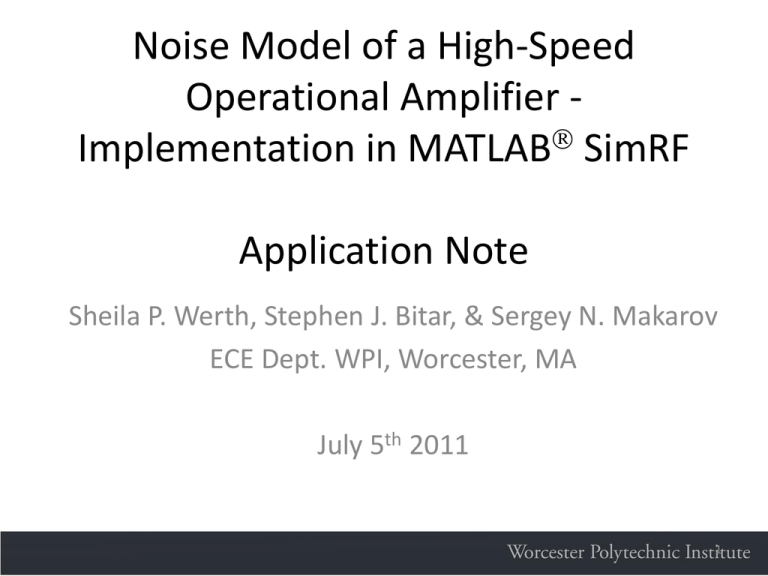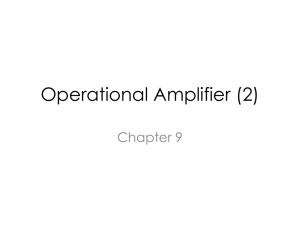Noise Model of a High-Speed Operational Amplifier
advertisement

Noise Model of a High-Speed Operational Amplifier Implementation in MATLAB SimRF Application Note Sheila P. Werth, Stephen J. Bitar, & Sergey N. Makarov ECE Dept. WPI, Worcester, MA July 5th 2011 1 Outline 1. 2. 3. 4. 5. Concept of a noisy operational amplifier Two basic op-amp circuits Equivalent input noise Extra contribution of noisy resistors R1, R2 Generic model of an op-amp circuit with noise – noise figure 6. Noise figure of an op-amp 7. MATLAB script for finding the noise figure 8. How is the noise model of an operational amplifier implemented in SimRF? 9. Test of op-amp model 10. Amplifier model example in SimRF 2 Concept of a noisy operational amplifier Op-amp datasheet reports: en [nV/ Hz], in [pA/ Hz] Resistor noise model: eR 4kTRB [V] Amplifier noise model: eN B en [V], i N B in [A] B – circuit bandwidth in Hz (bandwidth over which white noise is collected) 3 Two basic op-amp circuits (inv. and non-inv. configurations) Inverting configuration : S (t ) 0 Non- inverting configuration: S (t ) 0 R2 R1 RS R2 out (t ) eN (t ) ( R1 RS )iN (t ) R1 RS R 2 equivalentinput noise e Ni R2 R1 R2 out (t ) 1 eN (t ) iN (t ) RS iN (t ) R1 R R2 1 equivalentinput noise e Ni 4 Equivalent input noise Inverting configuration: e Ni2 R R S R2 1 R2 Non-inverting configuration: 2 2 2 e N ( R1 RS ) 2 i N e Ni2 RR e N2 1 2 R1 R2 2 2 2 i N RS2 i N Example 1: Find noise voltage added by two operational amplifier circuits (inv. and non-inv. op-amps) given that 1. en 14 nV/ Hz, iN 1.8 pA/ Hz (LM7171 of National Semiconductor); 2. RS 1k, R1 1k, R2 100k ; 3. The circuit bandwidth B is 20 kHz in every case; 4. The voltage noise of resistors is neglected. Solution: Equivalent input noise becomes eNi 2.08μV, eNi 2.01μV for the inverting and non-inverting amplifier, respectively. At the output to the amplifier, these values are transformed (through gain multiplication) to eNout 0.104mV, eNout 0.203mV. 5 Extra contribution of noisy resistors R1, R2 Inverting configuration: e Ni2 R RS e R21 1 R2 Non-inverting configuration: 2 2 e R 2 e Ni2 R2 R1 R2 2 2 R1 e R1 R1 R2 2 2 e R 2 6 Extra contribution of noisy resistors R1, R2 (cont.) Example 2: How do the results of the previous example change if the thermal noise of the two resistors R1 1k, R2 100k is additionally taken into account? Assume room temperature, T= 298K. Solution: For the inverting amplifier, the contribution of noisy resistors into the equivalent input noise is obtained using the superposition principle; it has the form eNi 3.29 10 13 1.32 10 14 0.59 μV at the input to the inverting amplifier. Similarly, one has eNi 3.23 10 13 3.23 10 15 0.57μV for the non-inverting amplifier. 7 Generic model of an op-amp circuit with noise – noise figure Noise factor: NF 1 N Noise figure: NFdB 10log10 1 a N in Na N in 2 Added noise: N a eNi [V2 ] Inf. input res.: Nin e 4kTRS B [V ] 2 RS Input (reference) noise: 2 2 e RS Matched input res.: N in kTRS B [V 2 ] 4 (MATLAB SimRF) 8 Noise figure of an op-amp may be surprisingly high… Example 3: Determine the noise figure of an inverting amplifier at room temperature taking into account extra noise contributions due to noisy resistors R1 , R2 . It is given that 1. en 14 nV/ Hz, in 1.8 pA/ Hz (LM7171 high-speed op-amp); 2. RS 50, R1 50, R2 5k ; 3. The circuit bandwidth B is 20 kHz. Solution: Total equivalent input noise to the amplifier includes semiconductor noise and resistor noise; the result becomes e Ni 4.10 10 12 1.71 10 14 2.02μV The added noise power referenced to amplifier’s input is given by N a eNi2 3.941012 [V2 ] Input or reference noise ( B 20 kHz ): Ni kTRS B 4.111015 [V2 ], RS 50 Therefore, N NFdB 10log10 1 a 10log10 1 9.96102 30dB ! N in 9 … but it decreases with a higher source resistance (causing a higher input noise) Example 4: Solve example 3 when RS 1k, R1 1k, R2 100k . Solution: NFdB 18dB …or when a better IC chip is used Example 5: Solve example 3 for LMH6624 op-amp from National Semiconductor with en 0.9 nV/ Hz . Solution: NFdB 10dB Question: Why use an op-amp then? Answer: One major advantage is a high gain; another advantage is matching flexibility 10 MATLAB script for finding the noise figure using the previous analysis: clear all; k = 1.38066e-23; T = 298; VT = 4*k*T; B = 2e4; % % % % Boltzmann constant [J/K] temperature [K] temperature constant [W/Hz] system (noise) bandwidth, Hz (cancels out) % Amplifier parameters en = 14e-9; % required (datasheet) in = 1.8e-12; % required (datasheet) RS = 1e3; % use an estimate when the exact value is not available R1 = 1e3; % required R2 = 100e3; % required Nin= k*T*RS*B; % reference input noise power (Pozar) % Inverting amplifier inv.eNi = sqrt(B)*sqrt( (R1+RS+R2)^2/R2^2*en^2 + (R1+RS)^2*in^2); inv.eR1 = sqrt(4*k*T*R1*B); % rms voltage noise inv.eR2 = sqrt(4*k*T*R2*B); % rms voltage noise inv.eR = sqrt(inv.eR1^2 + ((R1+RS)/R2)^2*inv.eR2^2); % inv inv.eNi = sqrt(inv.eNi^2 + inv.eR^2); inv.Na = inv.eNi^2; inv.NF = 10*log10(1 + inv.Na/Nin); inv % Non-inverting amplifier noninv.eNi = sqrt(B)*sqrt( en^2 + (R1*R2/(R1+R2))^2*in^2 +RS^2*in^2); noninv.eR1 = sqrt(4*k*T*R1*B); % rms voltage noise noninv.eR2 = sqrt(4*k*T*R2*B); % rms voltage noise noninv.eR = sqrt((R2/(R1+R2))^2*noninv.eR1^2 + (R1/(R1+R2))^2*noninv.eR2^2); % non-inv noninv.eNi = sqrt(noninv.eNi^2 + noninv.eR^2); noninv.Na = noninv.eNi^2; noninv.NF = 10*log10(1 + noninv.Na/Nin); noninv 11 How is the noise model of an operational amplifier implemented in SimRF? 1. Run MATLAB script given above and calculate the op-amp noise figure in dB. If you do not know source impedance RS exactly, use an estimated value. 2. Insert the noise figure value into the amplifier block 3. Explore block “SimRF parameters” 4. Set noise reference impedance to be exactly equal to the value of your source impedance RS identified previously. 5. Set noise bandwidth greater than or equal to the expected system bandwidth 12 Test of op-amp model 1. Construct the op-amp model in SimRF as described above 2. Short out its input 3. Measure rms added noise at the output 4. Compare this value with the corresponding theoretical prediction Theoretical prediction (based on Example 3): For an inverting amplifier at room temperature with 1. en 14 nV/ Hz, iN 1.8 pA/ Hz (LM7171 high-speed op-amp); 2. RS 50, R1 50, R2 5k ; 3. Circuit bandwidth of 20 kHz. find total added output noise taking into account semiconductor/resistor noise. Solution: Total equivalent input noise to the amplifier was found in example 3: eNi 2.02μV Total output noise to the amplifier is the input noise times the voltage gain: eNout G eNi 101μV 13 SimRF set up Parameters: You already calculated a noise figure of 30dB for this particular amplifier with a voltage gain of 50. Now, enter these parameters: You calculated the noise figure based upon a 50 ohm reference impedance and B= 20 kHz so: 14 Theory vs. simulations The calculated rms output noise voltage is: eNout 101V The output from the experimental setup is a close match: eNout 98.7V The experimental setup calculates a running rms over a finite time window - this could be a source of error: Error 101 98.7 101 100% 2.3% 15 Amplifier model example in SimRF: basic RF power detector/AM radio 16






